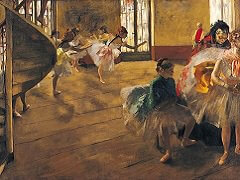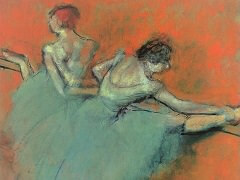Dancers in the Rehearsal Room, 1889 by Edgar Degas

During the period that Degas was furiously drawing and painting nude women in their boudoirs, he never laid aside his themes of the ballet. He was continuously trying to find new patterns and exploit fresh arrangements of color, space, and atmosphere for his dancers. Indeed, he energized these older subjects by his studies of anatomy. Originally, Degas saw his ballet subjects more pictorially; he had drawn the individual figures clothed and with considerable detail. Now he often studied them first nude, his intention being to stress the larger, simpler action and basic forms of the body in movement. Something of a similar influence crept into his painting from the sculpture he was making at the same time.
Here the familiar scene of the rehearsal room was taken up again. Once more the typical device of dancers in pairs, their poses compared and contrasted, the old weighting of one side of a composition with several figures and balancing it with emptiness on the other; the exaggeration of space by tipping up the floor; the light pouring in from windows in the rear, helping to stress contours and silhouettes.
The new element is a tremendous striving for unity. Gone are the charming decorative details, the enrichment of the surface, the exquisite, brief touches of almost "precious" color, cultivated so assiduously by Degas two decades earlier. The broad rich tones, the loose brush stroke (the stroke of a painter, rather than a draftsman), the gathering of light into a few major areas - all these the artist uses in a fresh way. No longer is he interested in violent movement; the theme of this ballet scene is pausation. No longer is he interested in individual piquancies of the dancers themselves. He is primarily concerned with the structure of the painting. He wishes to express, rather than depict. Of course the unfinished state of the picture makes it far easier to see his new intention and new direction.
















